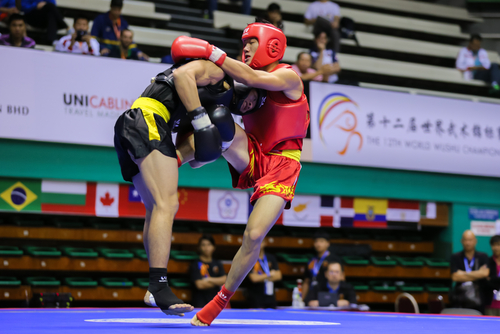Wushu competition rules for Sanshou

Image credit: Shutterstock.com
Apart from the taolu (form) discipline, competitive wushu also involves a sparring category, which is commonly known as sanshou. This involves both team and individual events, where opponents wrestle each other using Chinese-style wushu moves. One bout involves three two-minute rounds, with a minute of rest after each round.
Contestants are to compete according to their weight categories, and have to participate in a compulsory weighing-in session before the competition. They are weighed either in the nude, or wearing only light undergarments, to ensure fairness. If a competitor is too heavy, he or she will be given some time to lose the excess weight, or risk getting banned from competition.
The lei tai, or competition arena, is a wooden platform that measures 80 centimetres in height, and 800 centimetres in both length and width. A soft mat with a canvas surface tops it for safety purposes. The perimeter of the lei tai is lined with five-centimetre-wide red sidelines, and a yellow warning square, measuring 10 centimetres wide, is marked out inside the ring, 90 centimetres away from the perimeter. Protective mats are also placed around the platform, and these measure 30 centimetres thick and 200 centimetres wide.
All competitors must always give a Chinese fist salute, doing so by using the right fist to make contact with the left palm in front of the chest - when their names are called out before the match. Before starting to fight, they must also first perform the fist salute to each other and to their coaches. When the results are announced, both sides must fist-salute and change places with each other. Subsequently, they should also salute the judges and their opponent’s coach.
During the bout itself, the contestants must also take note of the regulations concerning attacking methods. They must not strike their opponents using their heads, elbows, or knees. In addition, twisting of joints, causing a head-over-heels fall, and pinning the opponent down on purpose are also not allowed. It is illegal to hit your opponent’s head if he or she is already down. Other areas that competitors are not allowed to attack at all times include the back of the head, the neck, and the crotch. They are also prohibited from attacking before or after the calls that signal the start and end of each bout.
The above are all deemed personal fouls and, if committed, a warning will be issued. Three warnings will result in a disqualification. Causing intentional harm to an opponent will also result in the disqualification of the perpetrator, and all of his or her previous results will be voided.
To receive the latest updates on the happenings in the Singapore sports scene, or to find out more about some of the latest programmes on offer at ActiveSG, like our Facebook page here.





![ActiveSG Academies and Clubs Logo (Solid Colour)[8647]](https://www.activesgcircle.gov.sg/hs-fs/hubfs/ActiveSG%20Circle%202023Theme/images/ActiveSG%20Academies%20and%20Clubs%20Logo%20(Solid%20Colour)%5B8647%5D.png?width=150&height=65&name=ActiveSG%20Academies%20and%20Clubs%20Logo%20(Solid%20Colour)%5B8647%5D.png)




-01.png?width=200&height=141&name=Team%20Singapore%20Logo%20(Red)-01.png)



